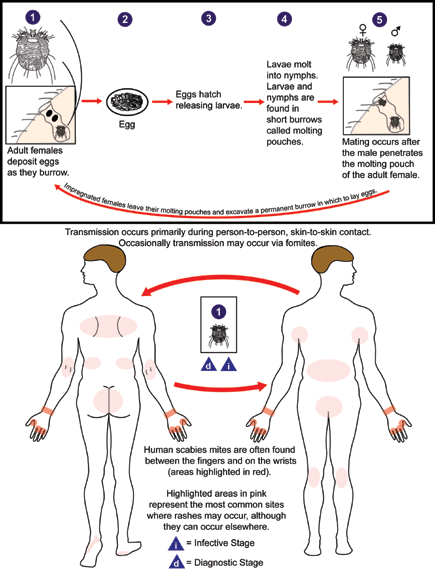 |
Sarcoptes scabiei undergoes
four stages in its life cycle: egg, larva, nymph and adult. Females
deposit 2-3 eggs per day as they burrow under the skin  .
Eggs are oval and 0.10 to 0.15 mm in length .
Eggs are oval and 0.10 to 0.15 mm in length  and
hatch in 3 to 4 days. After the eggs hatch, the larvae migrate to the
skin surface and burrow into the intact stratum corneum to construct
almost invisible, short burrows called molting pouches. The larval
stage, which emerges from the eggs, has only 3 pairs of legs and
hatch in 3 to 4 days. After the eggs hatch, the larvae migrate to the
skin surface and burrow into the intact stratum corneum to construct
almost invisible, short burrows called molting pouches. The larval
stage, which emerges from the eggs, has only 3 pairs of legs  and lasts about 3 to 4 days. After the larvae molt, the resulting
nymphs have 4 pairs of legs
and lasts about 3 to 4 days. After the larvae molt, the resulting
nymphs have 4 pairs of legs  .
This form molts into slightly larger nymphs before molting into adults.
Larvae and nymphs may often be found in molting pouches or in hair
follicles and look similar to adults, only smaller. Adults are round,
sac-like eyeless mites. Females are 0.30 to 0.45 mm long and 0.25 to
0.35 mm wide, and males are slightly more than half that size. Mating
occurs after the active male penetrates the molting pouch of the adult
female .
This form molts into slightly larger nymphs before molting into adults.
Larvae and nymphs may often be found in molting pouches or in hair
follicles and look similar to adults, only smaller. Adults are round,
sac-like eyeless mites. Females are 0.30 to 0.45 mm long and 0.25 to
0.35 mm wide, and males are slightly more than half that size. Mating
occurs after the active male penetrates the molting pouch of the adult
female  .
Mating takes place only once and leaves the female fertile for the rest
of her life. Impregnated females leave their molting pouches and wander
on the surface of the skin until they find a suitable site for a
permanent burrow. While on the skinís surface, mites hold onto the skin
using sucker-like pulvilli attached to the two most anterior pairs of
legs. When the impregnated female mite finds a suitable location, it
begins to make its characteristic serpentine burrow, laying eggs in the
process. After the impregnated female burrows into the skin, she
remains there and continues to lengthen her burrow and lay eggs for the
rest of her life (1-2 months). Under the most favorable of conditions,
about 10% of her eggs eventually give rise to adult mites. Males are
rarely seen; they make temporary shallow pits in the skin to feed until
they locate a femaleís burrow and mate. .
Mating takes place only once and leaves the female fertile for the rest
of her life. Impregnated females leave their molting pouches and wander
on the surface of the skin until they find a suitable site for a
permanent burrow. While on the skinís surface, mites hold onto the skin
using sucker-like pulvilli attached to the two most anterior pairs of
legs. When the impregnated female mite finds a suitable location, it
begins to make its characteristic serpentine burrow, laying eggs in the
process. After the impregnated female burrows into the skin, she
remains there and continues to lengthen her burrow and lay eggs for the
rest of her life (1-2 months). Under the most favorable of conditions,
about 10% of her eggs eventually give rise to adult mites. Males are
rarely seen; they make temporary shallow pits in the skin to feed until
they locate a femaleís burrow and mate.
Transmission occurs primarily by the transfer of the
impregnated females during person-to-person, skin-to-skin contact.
Occasionally transmission may occur via fomites (e.g., bedding or
clothing). Human scabies mites often are found between the fingers and
on the wrists. |
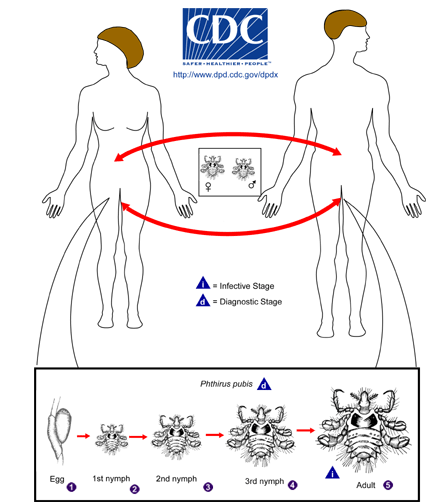 |
Pubic lice (Phthirus
pubis)
have three stages: egg, nymph and adult. Eggs (nits) are laid on a hair
shaft  .
Females will lay approximately 30 eggs during their 3-4 week life span.
Eggs hatch after about a week and become nymphs, which look like smaller
versions of the adults. The nymphs undergo three molts ( .
Females will lay approximately 30 eggs during their 3-4 week life span.
Eggs hatch after about a week and become nymphs, which look like smaller
versions of the adults. The nymphs undergo three molts ( , ,  , ,  )
before becoming adults )
before becoming adults  .
Adults are 1.5-2.0 mm long and flattened. They are much broader in
comparison to head and body lice. Adults are found only on the human
host and require human blood to survive. If adults are forced off the
host, they will die within 24-48 hours without a blood feeding. Pubic
lice are transmitted from person to person most-commonly via sexual
contact, although fomites (bedding, clothing) may play a minor role in
their transmission.. .
Adults are 1.5-2.0 mm long and flattened. They are much broader in
comparison to head and body lice. Adults are found only on the human
host and require human blood to survive. If adults are forced off the
host, they will die within 24-48 hours without a blood feeding. Pubic
lice are transmitted from person to person most-commonly via sexual
contact, although fomites (bedding, clothing) may play a minor role in
their transmission.. |
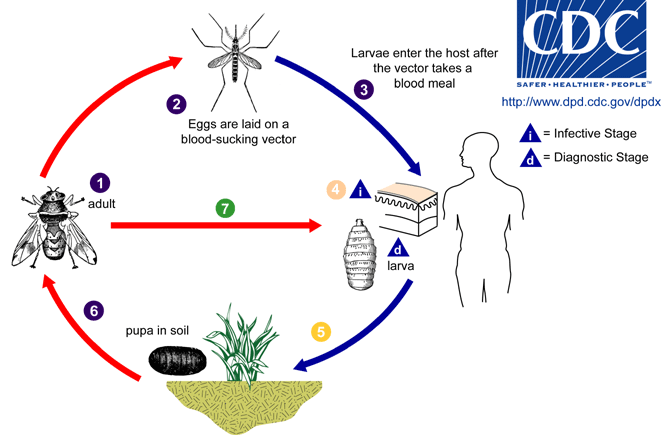 |
Adults of Dermatobia
hominis are
free-living flies  .
Adults capture blood-sucking arthropods (such as mosquitoes) and lay
eggs on their bodies, using a glue-like substance for adherence .
Adults capture blood-sucking arthropods (such as mosquitoes) and lay
eggs on their bodies, using a glue-like substance for adherence  .
Bot fly larvae develop within the eggs, but remain on the vector until
it takes a blood meal from a mammalian or avian host. Newly-emerged bot
fly larvae then penetrate the host's tissue .
Bot fly larvae develop within the eggs, but remain on the vector until
it takes a blood meal from a mammalian or avian host. Newly-emerged bot
fly larvae then penetrate the host's tissue  .
The larvae feed in a subdermal cavity .
The larvae feed in a subdermal cavity  for
5-10 weeks, breathing through a hole in the host's skin. Mature larvae
drop to the ground for
5-10 weeks, breathing through a hole in the host's skin. Mature larvae
drop to the ground  and
pupate in the environment. Larvae tend to leave their host during the
night and early morning, probably to avoid desiccation. After
approximately one month, the adults emerge and
pupate in the environment. Larvae tend to leave their host during the
night and early morning, probably to avoid desiccation. After
approximately one month, the adults emerge  to
mate and repeat the cycle. Other genera of myiasis-causing flies (including Cochliomyia,
Cuterebra, and Wohlfahrtia)
have a more direct life cycle, where the adult flies lay their eggs
directly in, or in the vicinity of, wounds on the host to
mate and repeat the cycle. Other genera of myiasis-causing flies (including Cochliomyia,
Cuterebra, and Wohlfahrtia)
have a more direct life cycle, where the adult flies lay their eggs
directly in, or in the vicinity of, wounds on the host  .
In Cochliomyia and Wohlfahrtia infestations,
larvae feed in the host for about a week, and may migrate from the
subdermis to other tissues in the body, often causing extreme damage in
the process. .
In Cochliomyia and Wohlfahrtia infestations,
larvae feed in the host for about a week, and may migrate from the
subdermis to other tissues in the body, often causing extreme damage in
the process. |
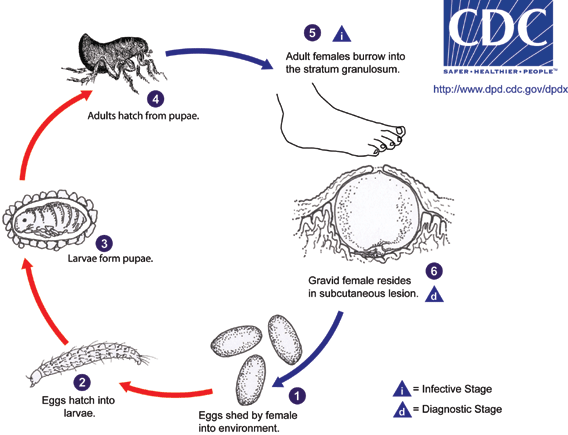 |
Eggs are shed by the gravid female into the environment  .
Eggs hatch into larvae .
Eggs hatch into larvae  in
about 3-4 days and feed on organic debris in the environment. Tunga
penetrans has
two larval stages before forming pupae in
about 3-4 days and feed on organic debris in the environment. Tunga
penetrans has
two larval stages before forming pupae  .
The pupae are in cocoons that are often covered with debris from the
environment (sand, pebbles, etc). The larval and pupal stages take
about 3-4 weeks to complete. Afterwards, adults hatch from pupae .
The pupae are in cocoons that are often covered with debris from the
environment (sand, pebbles, etc). The larval and pupal stages take
about 3-4 weeks to complete. Afterwards, adults hatch from pupae  and
seek out a warm-blooded host for blood meals. Both males and females
feed intermittently on their host, but only mated females burrow into
the skin (epidermis) of the host, where they cause a nodular swelling and
seek out a warm-blooded host for blood meals. Both males and females
feed intermittently on their host, but only mated females burrow into
the skin (epidermis) of the host, where they cause a nodular swelling  .
Females do not have any specialized burrowing organs, and simply claw
into the epidermis after attaching with their mouthparts. After
penetrating the stratum corneum, they burrow into the stratum granulosum,
with only their posterior ends exposed to the environment .
Females do not have any specialized burrowing organs, and simply claw
into the epidermis after attaching with their mouthparts. After
penetrating the stratum corneum, they burrow into the stratum granulosum,
with only their posterior ends exposed to the environment  .
The female fleas continue to feed and their abdomens extend up to about
1 cm. Females shed about 100 eggs over a two-week period, after which
they die and are sloughed by the hostís skin. Secondary bacterial
infections are not uncommon with tungiasis. .
The female fleas continue to feed and their abdomens extend up to about
1 cm. Females shed about 100 eggs over a two-week period, after which
they die and are sloughed by the hostís skin. Secondary bacterial
infections are not uncommon with tungiasis. |
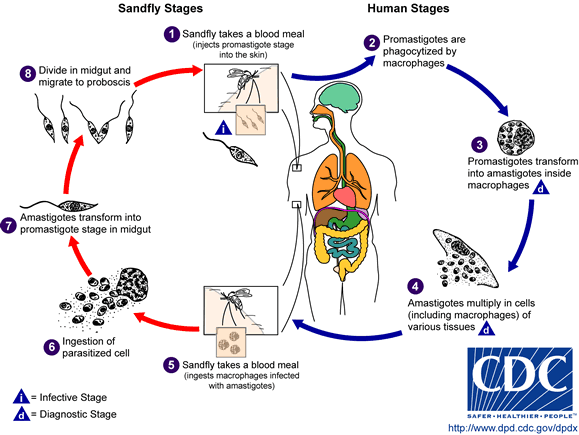 |
Leishmaniasis is transmitted by the bite of female
phlebotomine sandflies. The sandflies inject the infective stage,
promastigotes, during blood meals  .
Promastigotes that reach the puncture wound are phagocytized by
macrophages .
Promastigotes that reach the puncture wound are phagocytized by
macrophages  and
transform into amastigotes and
transform into amastigotes  .
Amastigotes multiply in infected cells and affect different tissues,
depending in part on the Leishmania species .
Amastigotes multiply in infected cells and affect different tissues,
depending in part on the Leishmania species  .
This originates the clinical manifestations of leishmaniasis. Sandflies
become infected during blood meals on an infected host when they ingest
macrophages infected with amastigotes ( .
This originates the clinical manifestations of leishmaniasis. Sandflies
become infected during blood meals on an infected host when they ingest
macrophages infected with amastigotes ( , ,  ).
In the sandfly's midgut, the parasites differentiate into promastigotes ).
In the sandfly's midgut, the parasites differentiate into promastigotes ,
which multiply and migrate to the proboscis ,
which multiply and migrate to the proboscis  . . |




